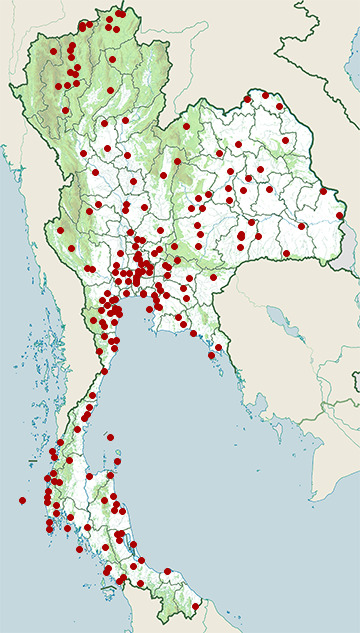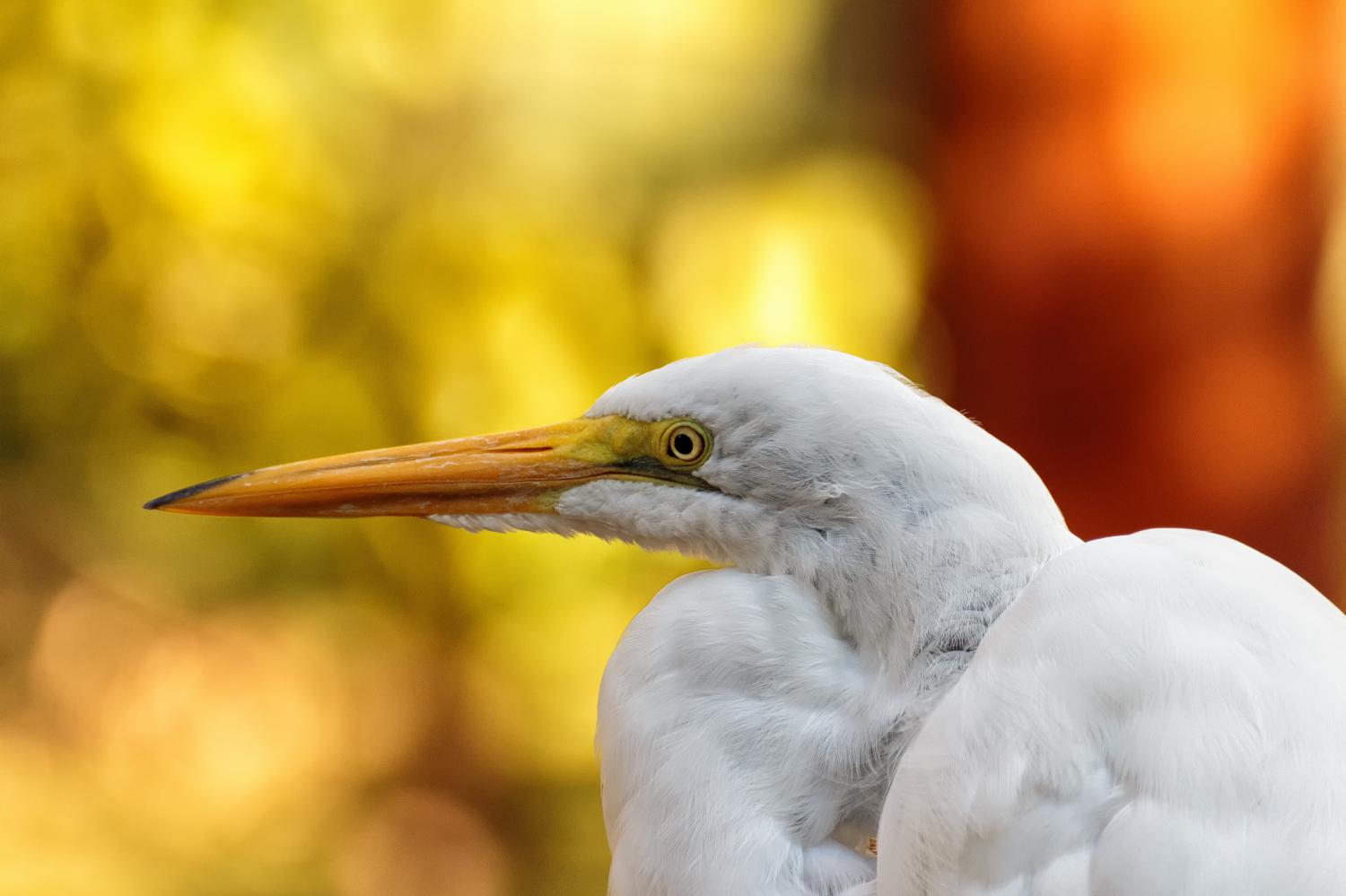Species of Thailand
Great egret
Ardea alba
John Edward Gray, 1831
In Thai: นกยางโทนใหญ่
The eastern great egret (Ardea alba modesta), a white heron in the genus Ardea, is a subspecies of the great egret (A. alba). It was first described by British ornithologist John Edward Gray in 1831.
Taxonomy
Although a study argued for full species status in 2005, most taxonomists consider it to be a subspecies.
Description
Measuring 83–103 cm (33–41 in) in length and weighing 0.7–1.2 kg (1.5–2.6 lb), the eastern great egret is a large heron with all-white plumage. Its bill is yellow in the breeding season and black at other times, and its long legs are red or black. The colours of the bare parts change during the breeding season. The breeding plumage is also marked by long neck plumes and a green facial area. The eastern great egret can be distinguished from other white egrets and herons in Asia and Australia by its very long neck, one and a half times as long as its own body.
Range and habitat
The eastern great egret has a wide distribution throughout Asia and Oceania, with breeding populations in Pakistan, India, Sri Lanka, Bangladesh, Burma, Thailand, China, Korea, north-eastern Russia, Japan, Indochina, Indonesia, Papua New Guinea, the Solomon Islands, Australia, and New Zealand. The egret breeds across Australia but only rarely in the southwest of the continent or dry interior. The largest colonies within Australia are in the Top End and Channel Country, which can number several thousand pairs. Colonies in the southeast of Australia can number several hundred pairs. The bird is an uncommon autumn and winter visitor to Tasmania.
Feeding
The diet includes vertebrates such as fish, frogs, small reptiles, small birds and rodents, and invertebrates such as insects, crustaceans, and molluscs. The eastern great egret hunts by wading or standing still in shallow water and "spearing" prey with its bill.
Breeding
The eastern great egret often breeds in colonies with other herons, egrets, cormorants, spoonbills and ibises. One brood is raised a year, although the breeding season varies within Australia. In the north of the country it is in March to May, in southern and central Queensland December and January, and October to December in the south. Located atop trees at a height of 20 m (60 ft) or more, the nest is a flat wide platform of dry branches and sticks with a shallow basin for eggs and young. The clutch consists of anywhere from two to six pale blue-green eggs, with three or four being the usual number. They are oval in shape and measure 52 x 36 mm.
Status
The subspecies is protected in Australia under the National Parks and Wildlife Act 1974. In New Zealand, where it is known as the kōtuku, the eastern great egret is highly endangered, with only one breeding site at Okarito Lagoon. It is featured on the reverse side of a New Zealand $2 coin.
This article uses material from Wikipedia released under the Creative Commons Attribution-Share-Alike Licence 3.0. Eventual photos shown in this page may or may not be from Wikipedia, please see the license details for photos in photo by-lines.
Category / Seasonal Status
BCST Category: Recorded in an apparently wild state within the last 50 years
BCST Seasonal statuses:
- Resident or presumed resident
- Non-breeding visitor
Scientific classification
- Kingdom
- Animalia
- Phylum
- Chordata
- Class
- Aves
- Order
- Pelecaniformes
- Family
- Ardeidae
- Genus
- Ardea
- Species
- Ardea alba
Common names
- Thai: นกยางโทนใหญ่
Synonyms
- Ardea modesta
Conservation status

Least Concern (IUCN3.1)
Photos
Please help us review the bird photos if wrong ones are used. We can be reached via our contact us page.
Range Map

- Amphawa District, Samut Songkhram
- Ao Phang-Nga National Park
- Ban Laem District, Phetchaburi
- Ban Lat District, Phetchaburi
- Ban Lueam District, Nakhon Ratchasima
- Ban Phai District, Khon Kaen
- Ban Pho District, Chachoengsao
- Ban Sang District, Prachinburi
- Bang Ban District, Phra Nakhon Si Ayutthaya
- Bang Kruai District, Nonthaburi
- Bang Len District, Nakhon Pathom
- Bang Pa In District, Phra Nakhon Si Ayutthaya
- Bang Pahan District, Phra Nakhon Si Ayutthaya
- Bang Pakong District, Chachoengsao
- Bang Phra Non-Hunting Area
- Bang Pu Recreation Centre
- Bang Saphan Noi District, Prachuap Khiri Khan
- Bangkok Province
- Borabue District, Maha Sarakham
- Bueng Boraped Non-Hunting Area
- Bueng Khong Long Non-Hunting Area
- Chaiyo District, Ang Thong
- Chatturat District, Chaiyaphum
- Chiang Dao District, Chiang Mai
- Chiang Dao Wildlife Sanctuary
- Chiang Saen District, Chiang Rai
- Chum Ta Bong District, Nakhon Sawan
- Doi Inthanon National Park
- Doi Lo District, Chiang Mai
- Doi Pha Hom Pok National Park
- Doi Suthep - Pui National Park
- Doi Tao District, Chiang Mai
- Fang District, Chiang Mai
- Hat Wanakon National Park
- Hat Yai District, Songkhla
- Hua Hin District, Prachuap Khiri Khan
- Huai Chorakhe Mak Reservoir Non-Hunting Area
- Huai Kha Khaeng Wildlife Sanctuary
- Huai Sala Wildlife Sanctuary
- Huai Talat Reservoir Non-Hunting Area
- In Buri District, Sing Buri
- Kabin Buri District, Prachinburi
- Kaeng Khoi District, Saraburi
- Kaeng Krachan District, Phetchaburi
- Kaeng Krachan National Park
- Kaeng Krung National Park
- Kamphaeng Saen District, Nakhon Pathom
- Kanthararom District, Sisaket
- Kantharawichai District, Maha Sarakham
- Khanom District, Nakhon Si Thammarat
- Khao Dinsor (Chumphon Raptor Center)
- Khao Laem National Park
- Khao Lak - Lam Ru National Park
- Khao Luang National Park
- Khao Nam Khang National Park
- Khao Nang Phanthurat Forest Park
- Khao Phra - Bang Khram Wildlife Sanctuary
- Khao Sam Roi Yot National Park
- Khao Sok National Park
- Khao Yai National Park
- Khao Yoi District, Phetchaburi
- Khemarat District, Ubon Ratchathani
- Khlong Luang District, Pathum Thani
- Khuan Khanun District, Phatthalung
- Khung Kraben Non-Hunting Area
- Khura Buri District, Phang Nga
- Klaeng District, Rayong
- Ko Chang National Park
- Ko Lanta National Park
- Ko Phayam
- Ko Phra Thong
- Ko Samui District, Surat Thani
- Ko Sichang District, Chonburi
- Ko Tao
- Kui Buri National Park
- Kumphawapi District, Udon Thani
- Kut Thing Non-Hunting Area
- La-ngu District, Satun
- Laem Pak Bia
- Laem Son National Park
- Mae Ai District, Chiang Mai
- Mae Chan District, Chiang Rai
- Mae Mo District, Lampang
- Mae Taeng District, Chiang Mai
- Mu Ko Phetra National Park
- Mueang Buriram District, Buriram
- Mueang Chachoengsao District, Chachoengsao
- Mueang Chaiyaphum District, Chaiyaphum
- Mueang Chiang Mai District, Chiang Mai
- Mueang Chiang Rai District, Chiang Rai
- Mueang Chonburi District, Chonburi
- Mueang Kalasin District, Kalasin
- Mueang Kamphaeng Phet District, Kamphaeng Phet
- Mueang Kanchanaburi District, Kanchanaburi
- Mueang Khon Kaen District, Khon Kaen
- Mueang Krabi District, Krabi
- Mueang Lamphun District, Lamphun
- Mueang Loei District, Loei
- Mueang Lopburi District, Lopburi
- Mueang Nakhon Nayok District, Nakhon Nayok
- Mueang Nakhon Pathom District, Nakhon Pathom
- Mueang Nakhon Ratchasima District, Nakhon Ratchasima
- Mueang Nakhon Si Thammarat District, Nakhon Si Thammarat
- Mueang Nonthaburi District, Nonthaburi
- Mueang Pathum Thani District, Pathum Thani
- Mueang Pattani District, Pattani
- Mueang Phang Nga District, Phang Nga
- Mueang Phatthalung District, Phatthalung
- Mueang Phayao District, Phayao
- Mueang Phetchabun District, Phetchabun
- Mueang Phetchaburi District, Phetchaburi
- Mueang Phitsanulok District, Phitsanulok
- Mueang Phuket District, Phuket
- Mueang Ranong District, Ranong
- Mueang Ratchaburi District, Ratchaburi
- Mueang Samut Sakhon District, Samut Sakhon
- Mueang Samut Songkhram District, Samut Songkhram
- Mueang Saraburi District, Saraburi
- Mueang Satun District, Satun
- Mueang Songkhla District, Songkhla
- Mueang Sukhothai District, Sukhothai
- Mueang Suphanburi District, Suphan Buri
- Mueang Surat Thani District, Surat Thani
- Mueang Surin District, Surin
- Mueang Tak District, Tak
- Mueang Trat District, Trat
- Mueang Uttaradit District, Uttaradit
- Nam Nao National Park
- Non Sang District, Nong Bua Lamphu
- Non Thai District, Nakhon Ratchasima
- Nong Bong Khai Non-Hunting Area
- Nong Han Lake
- Nong Song Hong District, Khon Kaen
- Nong Suea District, Pathum Thani
- Nong Waeng Non-Hunting Area
- Nong Ya Plong District, Phetchaburi
- Nong Yai Area Development Project Under Royal Init
- Pa Sak Chonlasit Dam Non-Hunting Area
- Pai District, Mae Hong Son
- Pak Chong District, Nakhon Ratchasima
- Pak Kret District, Nonthaburi
- Pak Phanang District, Nakhon Si Thammarat
- Pak Phli District, Nakhon Nayok
- Pak Thale
- Pak Tho District, Ratchaburi
- Pak Thong Chai District, Nakhon Ratchasima
- Pathio District, Chumphon
- Pha Taem National Park
- Phaisali District, Nakhon Sawan
- Phanat Nikhom District, Chonburi
- Phayuha Khiri District, Nakhon Sawan
- Phi Phi Islands
- Phra Nakhon Si Ayutthaya District, Phra Nakhon Si Ayutthaya
- Phra Phrom District, Nakhon Si Thammarat
- Phutthamonthon District, Nakhon Pathom
- Pran Buri District, Prachuap Khiri Khan
- Pran Buri Forest Park
- Rattanawapi District, Nong Khai
- Sai Noi District, Nonthaburi
- Salak Pra Wildlife Sanctuary
- Samut Prakan Province
- San Sai District, Chiang Mai
- Sanam Bin Reservoir Non-Hunting Area
- Sanam Chai Khet District, Chachoengsao
- Sathing Phra District, Songkhla
- Satuek District, Buriram
- Sawi District, Chumphon
- Si Racha District, Chonburi
- Si Satchanalai District, Sukhothai
- Similan Islands
- Song Phi Nong District, Suphan Buri
- Sri Nakarin Dam National Park
- Sri Phang-nga National Park
- Su-ngai Kolok District, Narathiwat
- Takua Pa District, Phang Nga
- Taphan Hin District, Phichit
- Tha Sala District, Nakhon Si Thammarat
- Tha Takiap District, Chachoengsao
- Tha Wung District, Lopburi
- Tha Yang District, Phetchaburi
- Thai Mueang District, Phang Nga
- Thalang District, Phuket
- Thale Ban National Park
- Thale Noi Non-Hunting Area
- Thanyaburi District, Pathum Thani
- Thawat Buri District, Roi Et
- Wang Chan District, Rayong
- Wang Noi District, Phra Nakhon Si Ayutthaya
- Wat Phai Lom & Wat Ampu Wararam Non-Hunting Area
- Watthana Nakhon District, Sa Kaeo
- Wiang Chai District, Chiang Rai
- Yan Ta Khao District, Trang



